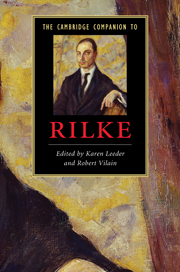7 - The Sonnets to Orpheus
from PART II - WORKS
Published online by Cambridge University Press: 28 July 2010
Summary
When Rilke moved to the Château de Muzot in the Canton of Wallis, Switzerland, in 1921, he was hoping he had found the place where he might complete his Duino Elegies. And indeed, having worked on this cycle, with several long interruptions, for a whole decade, Rilke did finally manage to bring this project to a conclusion in February 1922. This is, however, only one half of the success story that took place in Muzot. The other half concerns yet another major work that came into being there: The Sonnets to Orpheus, Rilke's last poetic cycle in German. Even before Rilke completed the Duino Elegies he had composed almost the entire first part of the sonnets, twenty-six poems altogether, in only four days (from 2 to 5 February 1922), and immediately after the Elegies had been finished, the second part consisting of another twenty-nine poems, was written in little more than a week (15-23 February). While the sonnets of the second part were rearranged after their composition, the first part predominantly reflects the chronological order in which the sonnets were written. The whole cycle was first published in 1923 by Insel in Leipzig. In part because of the closely connected genesis of The Sonnets to Orpheus and the Duino Elegies, Rilke always viewed the former in relation to the latter.
- Type
- Chapter
- Information
- The Cambridge Companion to Rilke , pp. 95 - 110Publisher: Cambridge University PressPrint publication year: 2010
- 2
- Cited by

